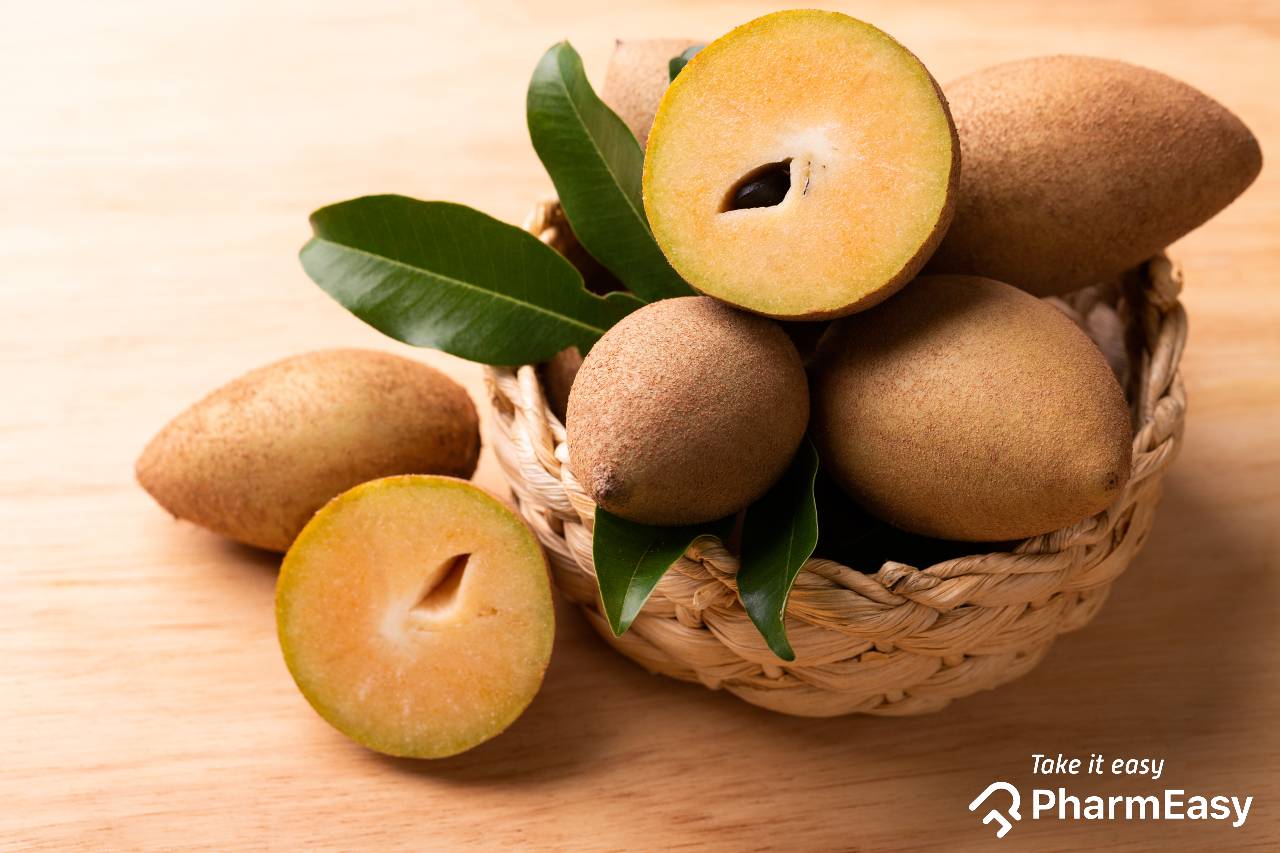8 Great Benefits of Sapota or Chikoo
By Dr. Malavika Athavale +2 more

Get,

to manage your symptom
Get your,


4 Cr+ families
benefitted

OTP sent to 9988776655



You’ve successfully subscribed to receive
doctor-approved tips on
Whatsapp

Get ready to feel your best.

Hi There,
Download the PharmEasy App now!!


Register to Avail the Offer
Send OTPBy continuing, you agree with our Privacy Policy and Terms and Conditions

Hi There,
Sign up on PharmEasy now!!
Trusted by 4 crore+ families

OTP sent to 9988776655



You have unlocked 25% off on medicines




Code: NU25
By Dr. Malavika Athavale +2 more
Table of Contents
Have you heard of Sapota and wondered what it is? You might be more familiar with its popular name in India, Chikoo. Sapota is a delicious, calorie-rich tropical fruit that is often grouped with other sweet fruits like mangoes.
Sapota is scientifically known as Manilkara zapota and belongs to the Sapotaceae family. It originally grew in the rainforests of Central America, particularly in regions such as Mexico and Belize. Over time, it has become widely cultivated in India, where Karnataka leads in production, followed by Maharashtra, Gujarat, Tamil Nadu, Andhra Pradesh, and West Bengal1.

Sapota, or chikoo, is typically oval or round in shape with a rough brown skin. When unripe, the fruit has a firm texture and white pulp due to its high latex content. As it ripens, the latex decreases, and the fruit becomes softer, with its flesh turning brown and sweet. At the centre, you’ll find several black, shiny, bean-like seeds.
Sapota is a naturally sweet, energy-dense fruit, providing approximately 83 calories per 100 grams. It is a good source of dietary fibre and contains several important vitamins and minerals. Notably, it is rich in vitamin A and vitamin C, which may contribute to overall well-being, including supporting natural immune function and skin maintenance2.
The fruit contains a polyphenolic compound known as tannin, which may exhibit astringent properties and has been studied for its potential anti-inflammatory, anti-viral, antibacterial, and anti-parasitic effects. Sapota also offers a range of essential minerals, including potassium, sodium, copper, iron, magnesium, and phosphorus, which may support general health.
Sapodilla is a tasty fruit that contains vitamin C, which may help support the body’s natural response to stress. Including it in your diet could contribute 39.33% to your daily vitamin C intake, potentially promoting overall well-being10.
Dr. Siddharth Gupta, B.A.M.S, M.D (Ayu)
We often enjoy fruits without fully knowing their potential. Sapota is one such fruit, while commonly eaten, its possible contributions to overall well-being are not widely recognised. Here are some potential uses of sapota for general health.

Sapota is rich in glucose and calories which may provide a quick source of natural energy, similar to bananas. Consuming it as part of a balanced diet may help replenish energy levels, especially during physically active periods. It may also be a suitable fruit option for individuals with increased energy needs, such as children and expectant mothers.

Sapota contains vitamin C and antioxidants, which may support the body’s natural immune function7. The presence of polyphenols may help combat oxidative stress and assist in neutralising harmful substances. Additionally, some studies suggest that sapodilla may exhibit antibacterial and antiviral properties, which could contribute to overall well-being3.
In my experience, I have observed that Sapota fruit contains a notable amount of vitamin A, which is essential for maintaining healthy vision, particularly as we age. Including sapota in your diet may support overall eye health and contribute to optimal vision10.
Dr. Anuja Bodhare, B.A.M.S, M.D (Ayu)

Sapota contains multiple vitamins, antioxidants, minerals, and dietary fibres, which may support healthy, glowing skin. The vitamin E content in sapodilla may help moisturise the skin, while its antioxidants may help protect the skin from oxidative stress, which is often linked to the ageing process4.
Additionally, the kernel oil from sapota seeds has been traditionally used for its potential soothing properties on skin irritations. It may offer relief when applied topically to minor skin discomforts.

Sapota contains essential nutrients that may support overall hair health. However, sapota seed oil is often considered more beneficial for hair care. It may help moisturise and soften hair, particularly for those with unmanageable curly hair. Additionally, it has been traditionally used to alleviate conditions like itchy scalp or seborrheic dermatitis, which could support a healthy scalp environment for hair growth5.
For a natural hair care remedy, you can grind sapota seeds into a paste and mix with castor oil. This mixture may be applied to the scalp and washed off the next day for potential benefits.

Sapota is rich in dietary fibres and contains tannins, which may help neutralise acid secretion in the gut, potentially alleviating symptoms of hyperacidity. It is also considered a natural laxative and may support regular bowel movements, potentially providing relief from constipation and helping to maintain intestinal health6.
I recommend considering Sapota as a potential natural remedy to support your urinary system and avoid kidney-related issues. The crushed seeds of sapota may help promote the elimination of waste through the urinary system, which could support overall kidney function and help maintain urinary health10.
Dr. Ashok Pal, B.A.M.S.

Sapota is a good source of calcium, phosphorus, and iron, which may contribute to maintaining strong bones1. Regular consumption of sapota could help provide essential minerals that support various bodily functions, including bone health and growth6.

Sapota is a good source of carbohydrates and essential nutrients, which may be beneficial during pregnancy. It could help reduce feelings of weakness and may support overall well-being, potentially alleviating common symptoms of pregnancy such as nausea and dizziness5,6.

Sapota contains magnesium and potassium, two minerals that may help maintain normal blood pressure. Magnesium plays a role in supporting the circulatory system by helping blood vessels to relax, which may make it easier for blood to flow. Potassium may also assist in balancing sodium levels in the body, which is important as high sodium levels are linked to hypertension. Consuming potassium and magnesium-rich foods like sapota may help support blood pressure management as part of a balanced diet6.
Based on traditional use, sapota may possess haemostatic properties, which might help manage bleeding associated with minor injuries or conditions like piles. However, further scientific studies are needed to confirm these effects10.
Dr. Smita Barode, B.A.M.S, M.S.
Sapota is packed with essential nutrients. It can be enjoyed on its own or used in a variety of dishes, such as desserts, smoothies, and milkshakes. Including sapota in your diet may contribute to overall physical and mental well-being1.
Chikoo Kheer with walnut offers a healthier variation of the traditional kheer, combining creaminess with the goodness of sapota and nuts. This versatile dessert can be enjoyed any time of the year, providing a satisfying option for those with a sweet craving.
Ingredients:
How to make Chikoo Kheer?
Nutritional Info:
Chikoo and Date Energy Bites are a great choice for a natural, energising snack. With the natural sweetness of chikoo and the nutritional benefits of dates, these bites offer a delicious and nutritious option for a quick boost.
Ingredients:
How to Make Chikoo and Date Energy Bites?
Nutritional Information (per serving – 2 energy bites):
The Chikoo Banana Smoothie blends the natural sweetness of chikoo with the smooth texture of banana, creating a delicious and satisfying drink. Easy to prepare, this smoothie may offer a refreshing way to begin your day with a nutrient-rich boost.
Ingredients:
How to Make Chikoo Banana Smoothie?
Nutritional Information (per serving):
In traditional practices, a paste made from ground sapodilla seeds has been used for its potential soothing properties. It may provide a calming effect on the skin and may help relieve minor discomforts such as irritation from insect bites10.
Dr. Rajeev Singh, BAMS
Individuals with certain health conditions or allergies should consult a healthcare professional before consuming chikoo to avoid potential adverse reactions.
Chikoo contains natural sugars, primarily fructose and sucrose, which contribute to its sweet taste. For individuals with diabetes or those following a low-carb diet, consuming chikoo in large quantities may cause a rapid increase in blood glucose levels. According to the USDA, 100 grams of chikoo contains approximately 124 kilo calories, 32.1 grams of carbohydrates, and 20.1 grams of total sugars8. It is recommended that individuals with diabetes or on a low-carb diet consume chikoo in moderation and consider its impact on their total carbohydrate intake.
Chikoo is a good source of dietary fibre, providing approximately 5.4 grams of fibre per 100 grams8. While fibre is beneficial for most people as it can help in digestion and promote gut health, individuals with certain gastrointestinal conditions, such as irritable bowel syndrome (IBS) or inflammatory bowel disease (IBD), may find high-fibre foods like chikoo difficult to digest.
Excessive fibre intake can lead to bloating, gas or abdominal discomfort. If you have a sensitive digestive system or have gastrointestinal issues, it’s essential to monitor your fibre intake and consider limiting your chikoo consumption accordingly.
Allergies to chikoo, though rare, have been reported. Chikoo contains proteins that can trigger allergic reactions in susceptible individuals. According to the Food Allergy Research & Education (FARE) organization, it’s crucial for people with known allergies to chikoo or latex (as chikoo belongs to the latex family) to avoid consuming chikoo to prevent allergic reactions. Common symptoms of chikoo allergy may include itching, hives, swelling of the lips or throat and difficulty breathing. If you suspect or experience any signs of an allergic reaction after consuming chikoo, seek immediate medical attention9.
Chikoo is considered safe for most pregnant and breastfeeding women when consumed in moderate amounts. However, due to individual differences and possible sensitivities, it’s advisable for pregnant or breastfeeding women to consult their healthcare provider before including chikoo in their diet. Chikoo is a good source of vitamins, minerals and fibre, which can be beneficial during pregnancy and breastfeeding. For example, 100 grams of chikoo provides approximately 24 mg of vitamin C, supporting the immune system during this crucial time.
If you experience any adverse effects after consuming chikoo, such as significant blood sugar spikes, digestive discomfort or signs of an allergic reaction, discontinue its consumption immediately and seek prompt medical advice. Your healthcare provider can provide personalized guidance based on your health condition and any observed reactions to chikoo (sapota)6.
Also Read: 10 Foods Good for Gut Health: Why You Must Eat them Daily!
Sapota or chikoo is a sweet tropical fruit rich in natural sugars, fibre, and vitamins like A and C. When eaten in moderation, it may support energy, digestion, and immune health. Individuals with diabetes, allergies, or digestive conditions should consult a healthcare provider before including it regularly in their diet.
Chikoo, also known as Sapota, is a tropical fruit with a sweet and unique flavour. Its taste is often described as a combination of pear, caramel and brown sugar, making it a delightful treat for those with a sweet tooth.
Chikoo (Sapota) is rich in dietary fibre, vitamins (such as vitamin C and vitamin A) and minerals (including potassium and calcium). These nutrients contribute to various health benefits, such as supporting digestion, boosting the immune system, promoting bone health and providing a quick energy boost.
Yes, chikoo contains significant dietary fibre, which helps in digestion and helps prevent constipation. Its fibre content promotes regular bowel movements and contributes to a healthy digestive system.
While chikoo (Sapota) is a nutritious fruit, it is relatively high in natural sugars and calories. As with any food, portion control is essential for weight management. Moderation and incorporating chikoo as part of a balanced diet can be beneficial.
Individuals with diabetes should enjoy chikoo (sapota) in moderation, as it contains natural sugars. It’s important to monitor blood sugar levels and account for the fruit’s carbohydrate content as part of effective glucose management.
Chikoo (Sapota) can be consumed in moderation during pregnancy. It provides essential nutrients, such as vitamin C and fibre, which can be beneficial for pregnant women. However, pregnant women should consult their healthcare provider for personalized dietary recommendations.
While allergies to chikoo are rare, some individuals may be allergic to chikoo (Sapota) proteins or experience cross-reactivity with latex due to chikoo belonging to the latex family. Individuals with known allergies to chikoo or latex should make sure to consult with a doctor before consuming it.
Choose ripe chikoo (Sapota) with a slightly soft texture and a sweet aroma. Avoid fruits with bruises or blemishes. To store, keep ripe chikoo at room temperature until they fully ripen. Once ripe, store them in the refrigerator to extend their shelf life.
Yes, chikoo’s (Sapota’s) sweet flavour and creamy texture make it an excellent addition to various desserts, smoothies and milkshakes. It pairs well with other fruits and complements both sweet and savoury dishes.
If the chikoo (Sapota) has seeds, simply cut the fruit in half and remove the seeds before eating. Alternatively, you can scoop out the flesh with a spoon or use it in recipes that include deseeded chikoo.
Disclaimer: The information provided here is for educational/awareness purposes only and is not intended to be a substitute for medical treatment by a healthcare professional and should not be relied upon to diagnose or treat any medical condition. The reader should consult a registered medical practitioner to determine the appropriateness of the information and before consuming any medication. PharmEasy does not provide any guarantee or warranty (express or implied) regarding the accuracy, adequacy, completeness, legality, reliability or usefulness of the information; and disclaims any liability arising thereof.
Links and product recommendations in the information provided here are advertisements of third-party products available on the website. PharmEasy does not make any representation on the accuracy or suitability of such products/services. Advertisements do not influence the editorial decisions or content. The information in this blog is subject to change without notice. The authors and administrators reserve the right to modify, add, or remove content without notification. It is your responsibility to review this disclaimer regularly for any changes.
Comments

Leave your comment...
You may also like
Comments